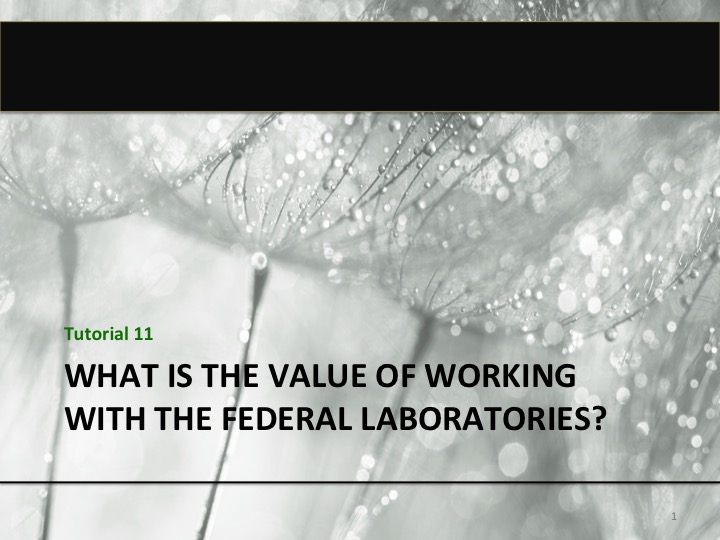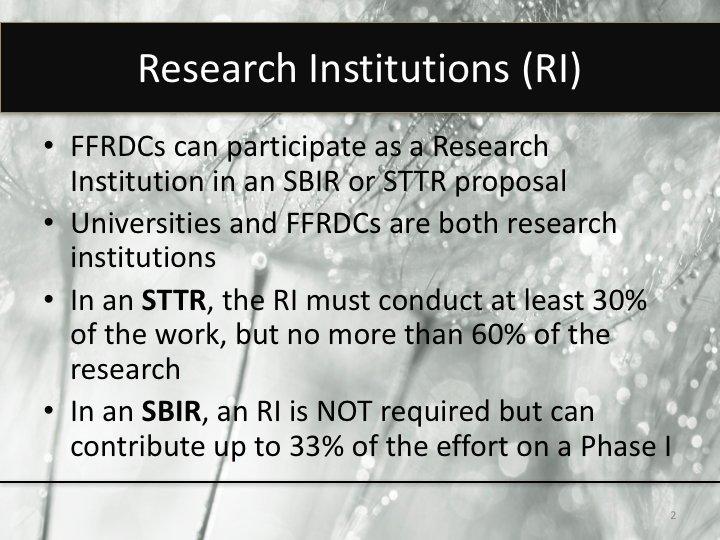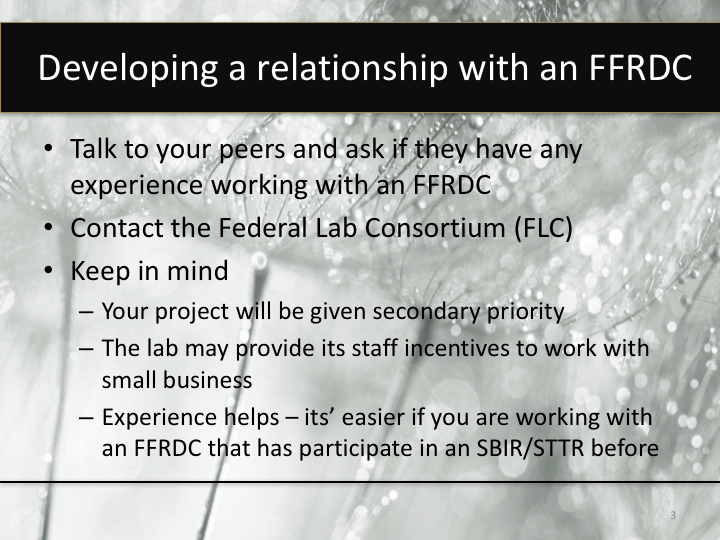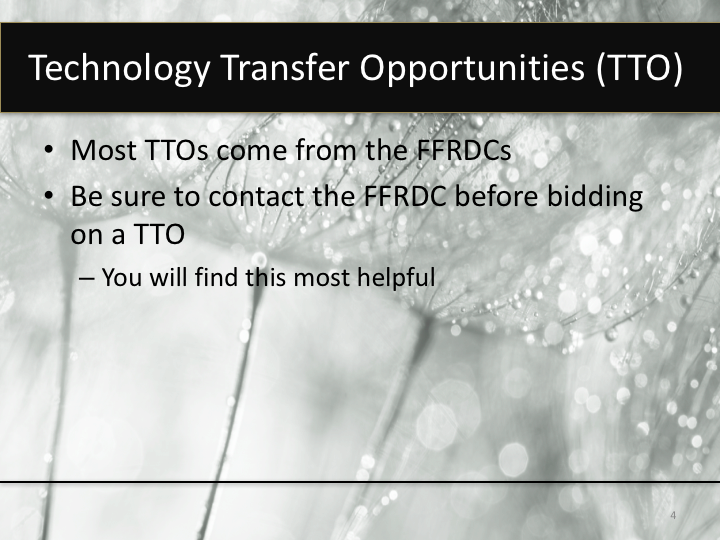Tutorial 11:
What is the Value of Working with the Federal Laboratories?
Federal Laboratories or, as they are commonly called, the National Labs can play an important role in an SBIR or STTR project. In this module we will focus upon a subset of the Federal Labs referred to as Federally Funded Research and Development Centers or FFRDCs. While there are over 250 Federal Laboratories, there are only about 40 FFRDCs. The distinguishing feature of an FFRDC is that it is operated or managed by a contractor, rather than by the Federal government. For example, Pacific Northwest National Laboratory is an FFRDC owned and funded by the U.S. Department of Energy (DOE), but managed by Battelle Memorial Institute.
As mentioned in previous modules, FFRDCs can participate in a Small Business Technology Transfer (STTR) proposal as the Research Institution (RI). Recall that the STTR program requires that the small business applicant team with a non-profit RI in order to cooperatively conduct research and development activities needed to advance an innovation. When looking for an RI to participate in an STTR proposal, universities are most commonly thought of first, but FFRDCs are eligible as well. As the Research Institution participating in an STTR proposal, the FFRDC must conduct at least 30%, but not more than 60% of the research. Most agencies, including the Department of Energy, will allow the principal investigator who is leading the STTR project to be primarily employed by the FFRDC rather than by the small business applicant.
FFRDCs can also participate as subcontractors in Small Business Innovation Research (SBIR) proposals. Although using an RI is not mandatory on an SBIR, as it is on an STTR, it may still make sense to subcontract part of the research to an FFRDC in order to enhance the qualifications of your team. An FFRDC can contribute up to 33% of the research in a Phase I SBIR and up to 50% in a Phase II SBIR project. By the way, it is no longer necessary to secure a waiver from the Small Business Administration (SBA) in order to include an FFRDC in your SBIR project – that requirement was eliminated in the 2011 SBIR/STTR Reauthorization.
An FFRDC can also serve as a provider of sophisticated facilities and/or equipment needed to conduct an SBIR or STTR project. A number of the FFRDCs have “user facilities” that are unique resources. Access to these “user facilities” can be provided to SBIR/STTR applicants that are willing to pay for their use. These user facilities will be discussed a little later in more detail.
There are several roles that FFRDCs cannot assume in the SBIR/STTR programs.
- Federally-funded research and development centers cannot apply directly for SBIR/STTR awards. This is because these programs are reserved for applicants who qualify as small business.
- FFRDCs cannot compete with the private sector, meaning they cannot provide services or resources to an SBIR/STTR project that is reasonably available from private firms.
Let’s consider how you might approach an FFRDC about participating in your firm’s SBIR/STTR proposal. Let’s assume that you don’t have any contacts within any of the Federal labs. Where might you begin? Start by talking with your peers. Ask if any of them have had experience working with an FFRDC and if yes, ask for the name(s) of the specific researcher with whom they worked. If this approach doesn’t yield any names, then contact the Federal Lab Consortium (FLC) and ask for help identifying an FFRDC that might be a good RI or subcontractor on your project.
When contacting an FFRDC, there are several important things to keep in mind.
- First, whatever work they agree to do for you on an SBIR/STTR project, may be given secondary priority to their primary mission and responsibilities. However, you will more than likely be treated well; just realize that they are in business to serve the federal governments primary interests.
- Second, the amount of SBIR/STTR funding that you can subcontract to an FFRDC is not going to be a significant incentive to the Laboratory. Many FFRDCs have billion dollar annual budgets, so 30-60% of a $150,000 Phase I project is not going to command much attention.
- Third, there may be other reasons that an FFRDC may want to work with you on an SBIR/STTR project. It may give the Laboratory an opportunity to work with another agency or program in the Federal government to which they otherwise would not have access. Also, an FFRDC may have a policy that encourages its staff to work with industry and/or small entities. Working with you will then help advance this goal.
- Finally, it will be easier to work with an FFRDC if it has previously served as a research institution or subcontractor on an SBIR or STTR proposal. With an experienced FFRDC, you will not be setting a new precedent or tilling new ground, so the contractual process should go faster. Prior experience also signals that the FFRDC will have a better grasp of the objectives, time frame, and desired outcomes of SBIR/STTR projects.
Once you have found an FFRDC with which you want to work, you will need to discuss with the Laboratory what kind of arrangement is best for your situation. The following is a short list of the more common mechanisms that FFRDCs may use
- The first is a Cooperative Research and Development Agreement (CRADA), which is described by the Federal Lab Consortium as “a principal mechanism used by federal laboratories to engage in collaborative efforts with non-federal partners.” The FLC states that CRADAs are a “relatively easy mechanism to implement,” and agencies like the Department of Energy have modular CRADA agreements that can expedite creation and approval. The FLC claims that CRADAs are “intended to take into account the needs and desires of private industry when commercializing a product,” so they will often be most appropriate for an FFRDC subcontracting to an SBIR/STTR applicant. Note that intellectual property and data rights will be shared between you and the FFRDC under a CRADA, subject to the terms of the agreement.
- A second mechanism is a Work for Others (WFO) agreement. WFO is sometimes referred to as “sponsored research,” and is defined as contracting with an FFRDC to perform specific work for your firm. You will pay their full cost, but you also will retain all IP and data rights created by the FFRDC under a WFO.
- A third mechanism is a User Facility agreement. As indicated earlier, some FFRDCs have unique facilities and equipment that can be made available to non-Federal parties like SBIR/STTR applicants. Like Work for Other agreements, you will pay the full cost of using such resources (including the cost of FFRDC staff to operate them), but you will retain any intellectual property and data rights created. As an aside, if you agree to publish results of your work at the user facility, you may be given a reduced price. A list of DOE designated user facilities is readily available. http://technologytransfer.energy.gov/docs/designateduserfacilities.html
- A fourth mechanism is a Licensing agreement. This is a mechanism used for out-licensing intellectual property belonging to an FFRDC to another entity such as an SBIR/STTR applicant. The license may be included as part of a CRADA. Out-licensing is used in special “Technology Transfer Opportunities” sections of the DOE SBIR/STTR program.
- The 5th mechanism for working with an FFRDC is referred to as Technical Assistance (TA). Some FFRDCs can provide limited technical assistance at little or no cost to the recipient. Examples of TAs include solving a specific problem, or improving a process or product.
If you are using an FFRDC on your Phase I SBIR or STTR proposal to DOE, then you are required to secure authorization in writing from the cognizant DOE contracting officer. Acceptable wording for this authorization is found in Part III.B of the DOE Funding Opportunity Announcement (FOA). Therefore, approval from just the FFRDC is not sufficient—authorization from DOE is also required. Fortunately, it isn’t mandatory that you include this authorization with your Phase I proposal, so you can secure it later prior to award.
In addition to the topics and subtopics that are developed by the 12 Program Offices participating in the DOE SBIR/STTR programs, you will also find “Technology Transfer Opportunity” (TTO) topics. Most TTO topics come from the Department of Energy’s FFRDCs, and are usually based on research the organization has conducted for the Department of Energy. TTOs create two opportunities for an SBIR/STTR applicant to interact with FFRDCs. First, it is highly advisable that you communicate with the FFRDC from which the TTO topic was issued to ensure that you understand the technology, and its stage of development. The FFRDC point of contact information can be found in the SBIR/STTR Topics document. Second, it is permissible, but not required that you make the FFRDC a subcontractor or research institution on your SBIR or STTR proposal. Such a relationship will to benefit the FFRDC facilitate tech transfer and enable you from the FFRDCs depth of knowledge and expertise. Your early communication with the FFRDC will provide you with considerable information that will assist you in making a decision as to whether or not you wish to include an FFRDC in your SBIR/STTR proposal.
Quiz: Tutorial 11: What is the value of working with the Federal Laboratories?
1
What makes FFRDCs unique is that, unlike other federal labs, they get Federal funding.
Nice Work
Try Again
2
Which of the following statements is NOT accurate?
Nice Work
Try Again
3
Fill in the blank: According to the National Science Foundation (NSF) there are approximately ____ FFRDCs in the U.S.
Nice Work
Try Again
4
Fill in the blanks: FFRDCs may not receive more than ___% of a Phase I SBIR, and not more than ___% of a Phase II SBIR
Nice Work
Try Again
5
Fill in the blanks: FFRDCs must do at least ___% of the research on an STTR project, but not more than ____%.
Nice Work
Try Again
6
Which of the following is not a mechanism by which FFRDCs might work with SBIR/STTR applicants?
Nice Work
Try Again



